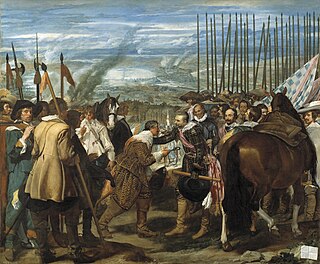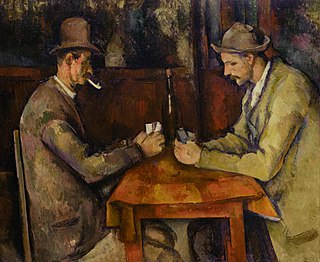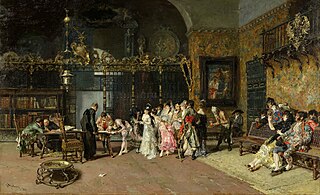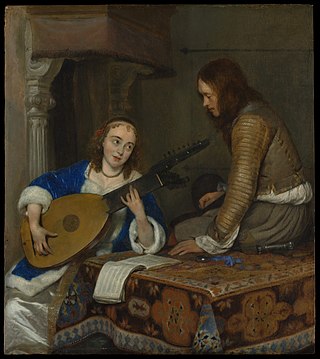
Édouard Manet was a French modernist painter. He was one of the first 19th-century artists to paint modern life, as well as a pivotal figure in the transition from Realism to Impressionism.

Genre art is the pictorial representation in any of various media of scenes or events from everyday life, such as markets, domestic settings, interiors, parties, inn scenes, work, and street scenes. Such representations may be realistic, imagined, or romanticized by the artist. Some variations of the term genre art specify the medium or type of visual work, as in genre painting, genre prints, genre photographs, and so on.

David Teniers the Younger or David Teniers II was a Flemish Baroque painter, printmaker, draughtsman, miniaturist painter, staffage painter, copyist and art curator. He was an extremely versatile artist known for his prolific output. He was an innovator in a wide range of genres such as history painting, genre painting, landscape painting, portrait and still life. He is now best remembered as the leading Flemish genre painter of his day. Teniers is particularly known for developing the peasant genre, the tavern scene, pictures of collections and scenes with alchemists and physicians.

Jean-Baptiste Édouard Detaille was a French academic painter and military artist noted for his precision and realistic detail. He was regarded as the "semi-official artist of the French army".

Jean-Louis-Ernest Meissonier was a French academic painter and sculptor. He became famous for his depictions of Napoleon, his armies and military themes. He documented sieges and manoeuvres and was the teacher of Édouard Detaille.

Military art is art with a military subject matter, regardless of its style or medium. The battle scene is one of the oldest types of art in developed civilizations, as rulers have always been keen to celebrate their victories and intimidate potential opponents. The depiction of other aspects of warfare, especially the suffering of casualties and civilians, has taken much longer to develop. As well as portraits of military figures, depictions of anonymous soldiers on the battlefield have been very common; since the introduction of military uniforms such works often concentrate on showing the variety of these.

Landscape painting, also known as landscape art, is the depiction of natural scenery such as mountains, valleys, trees, rivers, and forests, especially where the main subject is a wide view—with its elements arranged into a coherent composition. In other works, landscape backgrounds for figures can still form an important part of the work. Sky is almost always included in the view, and weather is often an element of the composition. Detailed landscapes as a distinct subject are not found in all artistic traditions, and develop when there is already a sophisticated tradition of representing other subjects.

Bartholomeus van der Helst was a Dutch painter. Considered to be one of the leading portrait painters of the Dutch Golden Age, his elegant portraits gained him the patronage of Amsterdam's elite as well as the Stadtholder's circle. Besides portraits, van der Helst painted a few genre pictures as well as some biblical scenes and mythological subjects.

The Musicians or Concert of Youths is a painting by the Italian Baroque master Michelangelo Merisi da Caravaggio (1571–1610). The work was commissioned by Cardinal Francesco Maria del Monte, who had an avid interest in music. It is one of Caravaggio’s more complex paintings, with four figures that were likely painted from life.

Girl Interrupted at Her Music is a painting by the Dutch artist Johannes Vermeer. It was painted in the baroque style, probably between the years 1658 and 1659, using oil on canvas. Since 1901 it has been in the Frick Collection in New York City.

Genre painting, a form of genre art, depicts aspects of everyday life by portraying ordinary people engaged in common activities. One common definition of a genre scene is that it shows figures to whom no identity can be attached either individually or collectively, thus distinguishing it from history paintings and portraits. A work would often be considered as a genre work even if it could be shown that the artist had used a known person—a member of his family, say—as a model. In this case it would depend on whether the work was likely to have been intended by the artist to be perceived as a portrait—sometimes a subjective question. The depictions can be realistic, imagined, or romanticized by the artist. Because of their familiar and frequently sentimental subject matter, genre paintings have often proven popular with the bourgeoisie, or middle class.

Michiel Sweerts or Michael Sweerts was a Flemish painter and printmaker of the Baroque period, who is known for his allegorical and genre paintings, portraits and tronies. The artist led an itinerant life and worked in Rome, Brussels, Amsterdam, Persia and India (Goa).

Anthonie Palamedesz., also Antonie Palamedesz, birth name Antonius Stevens, was a Dutch portrait and genre painter. He is in particular known for his merry company paintings depicting elegant figures engaged in play, music and conversation as well as guardroom scenes showing soldiers in guardrooms. Like many Dutch painters of his time, he painted portraits and still lifes, including vanitas still lifes. He further painted the staffage in a few views of the interior of churches. He played a major role in the development of genre painting in Delft in the mid 17th century.

The Card Players is a series of oil paintings by the French Post-Impressionist artist Paul Cézanne. Painted during Cézanne's final period in the early 1890s, there are five paintings in the series. The versions vary in size, the number of players, and the setting in which the game takes place. Cézanne also completed numerous drawings and studies in preparation for The Card Players series.

The Villa Vauban is an art museum in Luxembourg City. It exhibits 18th- and 19th-century paintings acquired from private collections.

The Spanish Wedding or La Vicaría (1868–1870) is a masterwork by Marià Fortuny i Marsal, also known as Marià Fortuny or Mariano Fortuny. La Vicaría exemplifies genre painting of the 19th century. The use of jewel tones, contrasts between light and dark, and the virtuosity of the work attest to Fortuny's talent. It resides at Museu Nacional d'Art de Catalunya in Barcelona, Spain.

A Cavalryman is an oil on canvas painting by French artist Alphonse-Marie-Adolphe de Neuville, from 1884. It depicts a French cavalryman on a yellow field. The work is in the collection of the Metropolitan Museum of Art, in New York.

A Woman Playing the Theorbo-Lute and a Cavalier is an oil on wood painting by Dutch artist Gerard ter Borch the Younger, created c. 1658. The work depicts a young woman playing a theorbo while her lover looks on. The painting is in the collection of the Metropolitan Museum of Art, in New York.

Lute Player is an early 17th-century painting by French artist Valentin de Boulogne. Done in oil on canvas, the painting depicts a young soldier playing a lute. The painting was originally in the collection of Cardinal Mazarin, and is now in the collection of the Metropolitan Museum of Art, in New York.

1807, Friedland is an oil on canvas painting by the French painter Ernest Meissonier, created in c. 1861–1875. It is held in the Metropolitan Museum of Art, in New York.




















